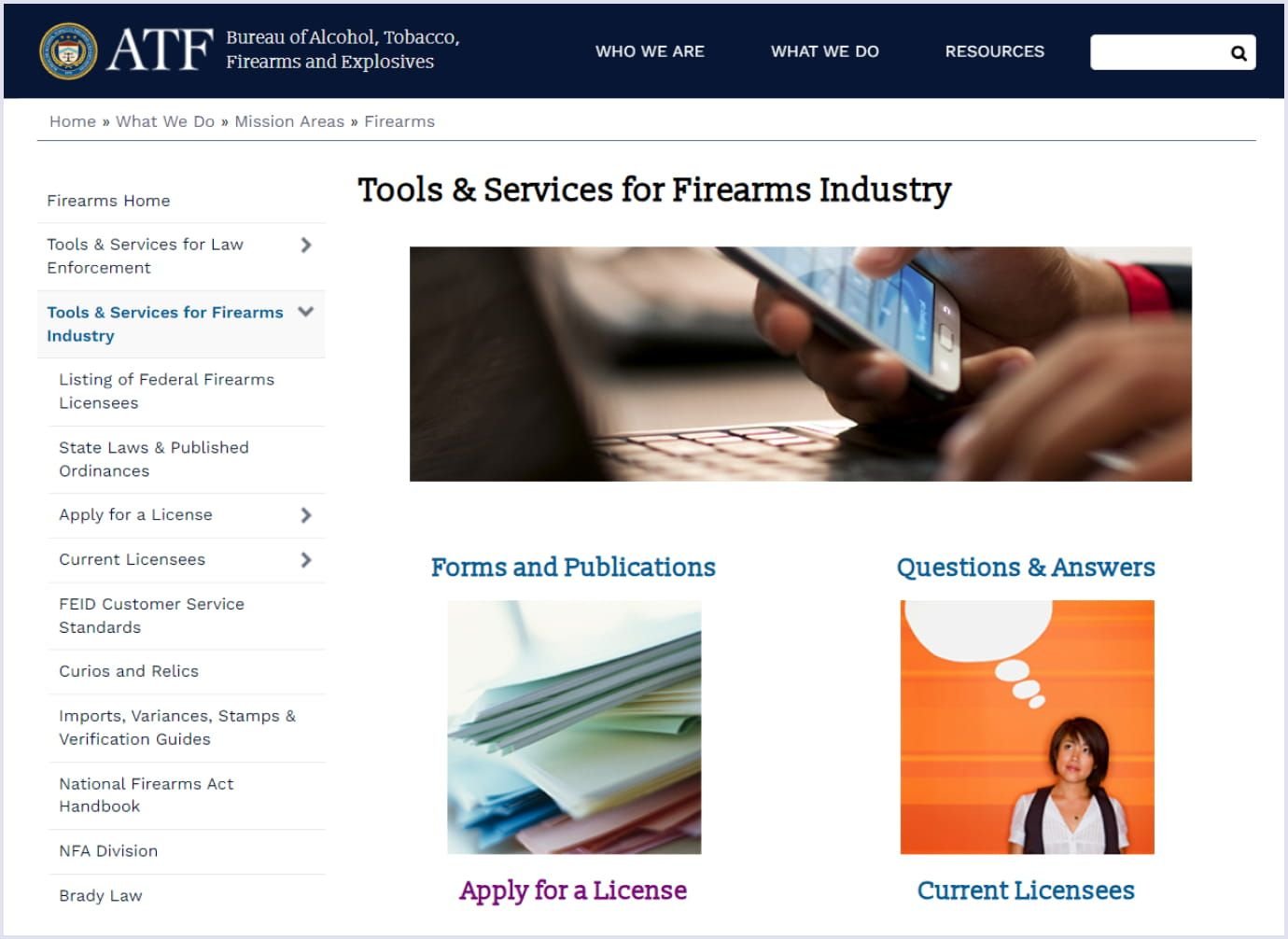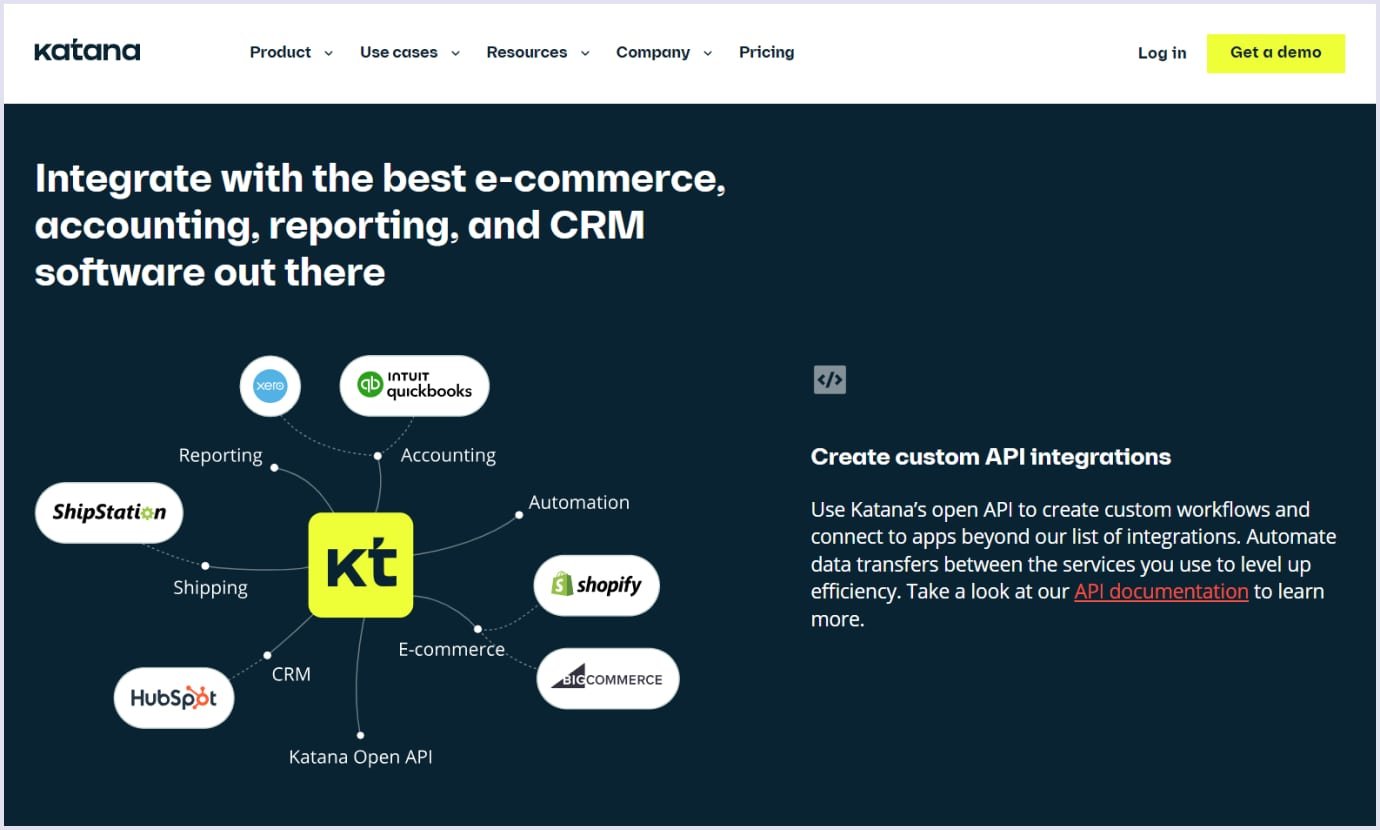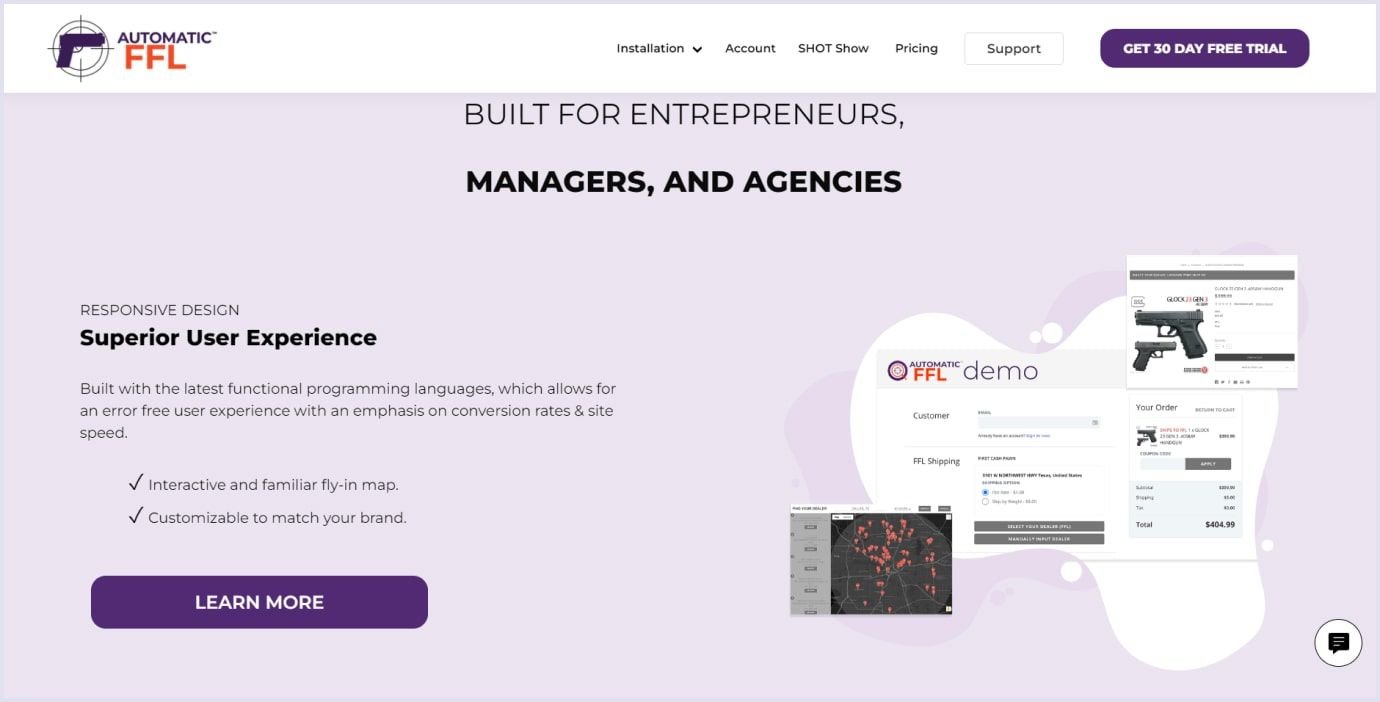Moving your gun sales to the virtual space is based on the online format's growth benefits. However, the firearms industry poses requirements, restrictions, and rules you must adhere to. These regulations are an indispensable part of your online firearm marketplace and define its specific features.
We prepared this post to help you learn how to sell firearms online. It discusses how you can shift your gun sales online, build your online marketplace, and improve its performance over time. Let’s get started.
How to restart your offline business and create a successful online gun store
Americans bought around 15.8 million guns in 2023. These sales accompany over a four-year continuous demand for guns, with 1.1 million gun sales in September 2023. So, scaling your offline gun business through an online presence is a profitable idea.
Here are several steps to expanding your store from offline to online:
Choose a domain. When creating a custom website for your firearm marketplace, ensure it has the same domain name as your offline store. Thus, you will make your store recognizable to your customers.
Choose an inventory management integration. When building your store website, ensure that firearms are presented in a convenient product catalog. Also, as you sell firearms online and offline, you will need a comprehensive inventory management system. It will help you keep your stock replenished as needed.
Set your website with convenient features. Your platform's buying process should have convenient and transparent features for buyers. For example, product listings should contain images and thorough descriptions. Also, the product page should be transparent about the price and delivery conditions for firearms.
Consider the legal aspects of selling firearms online. When shifting from offline to online firearms sales, you must consider legal aspects. Selling firearms online is similar to other product categories but with notable exceptions, such as obtaining proper licenses and permits. Check the section on legal and regulatory considerations below.
Develop a marketing strategy. Your store should be visible to both new and existing customers so you can adjust your marketing strategy for them. For example, you can nurture your existing customers with emails and discounts, or you can offer a launch promotion for new customers.

Assessing your offline business
Before moving online, you should assess your store’s current state. If you understand where you perform well, you will know the strong sides of your business and areas of improvement to evolve. Let’s discuss what aspects your assessment should include.
Evaluate the current state of your offline gun store
There is a widely used assessment method called SWOT analysis. It is a commonly used practice to outline your business’s strengths, weaknesses, opportunities, and threats, abbreviated as SWOT. They help you assess growth points and challenges and plan your business.
Having this outline in your hand will help you set realistic goals and develop a robust growth strategy.
Perform gun store SWOT analysis
Below, we outline strengths, weaknesses, opportunities, and threats that you can consider for your firearm store. Here they are.
Strengths
Specialization: If you choose a particular niche for your marketplace, such as specific firearms models, ammunition, and accessories, you can deliver personalized experiences to your target audience.
Inventory control: When expanding to the online world, you can use inventory management systems to help you replenish your stock when necessary.
Ammunition discounts: Offering special prices for specific categories of products or loyal customers will engage buyers who purchase in bulk or seek good deals.
Weaknesses
Limited customer base: The gun market is a narrow niche with a target audience with specific demands.
Competition from major retailers: Larger retailers have lower prices. So, it will be hard for a small gun store to compete with them, relying solely on price.
Possible liability: It is possible that if a customer buys from your store and misuses the weapon, you could be held liable for this.
Opportunities
- You can swell within the country via the website.
- Low overhead costs and operating expenses.
- The online store is open year-round, twenty-four hours a day.
- Price updates on websites are simple and quick.
- You can alert customers of fresh inventory promptly.
- Market specifically to both new and existing clients.
Threats
- Your store website could be taken down by hackers.
- Because of volume discounts, larger internet companies may provide better prices.
- Increased rivalry in the industry.
- Recession and economic difficulties.
- State sales tax must be collected on internet sales exceeding $1 million per year.
- Governmental or political gun control legislation.
We made an overview of the SWOT set for a firearm store in the image below.

Understanding legal and regulatory considerations
The specific nature of running a firearm store is legal compliance. Your store must comply with federal, state, and local regulations and laws, so obtaining the relevant licenses and permits is mandatory. Let’s break down these aspects for your firearms store, so you have a secure and compliant online firearms sales process.
Research federal, state, and local laws governing online gun sales
Federal, state, and local laws change constantly, and you must monitor those changes to avoid consequences resulting from non-compliance. It is imperative that you comprehend the relevant rules, secure the necessary licenses, and limit your online firearms sales to eligible clients.
For example, there can be limitations on specific product types, purchase frequency, and delivery terms. Compliance with these laws helps you avoid severe penalties when you sell firearms online. To meet laws, you can select locations where you deliver guns and specify in terms and conditions how you deliver your firearm products to specific locations.
Also, online sales in the gun industry are “conditional” and are completed upon specific conditions. For instance, in ordinary ecommerce, the sale is completed when a shopper receives the item. The online gun sales process depends on federal, state, and local legal requirements, which must be met. Also, background checks and delivery with a Federal Firearms Licensee (FFL) are mandatory for a shopper to receive the gun.
To protect yourself against legal prosecution and fines, check for the guide and other resources of the Bureau of Alcohol, Tobacco, Firearms, and Explosives (ATF). You can also find helpful information on obtaining FFL (Federal Firearms License).

Also, it is crucial that you adhere to state laws. They differ and can create additional risks or requirements that outweigh profit. So, it may be reasonable to research the state laws and restrict your deliveries to specific areas.
Remember that state laws on the firearms industry change often. To keep your business safe, we recommend that you consult an attorney.
Obtain necessary licenses and permits
Dealers in the firearms industry must get the FFL license from ATF. Otherwise, they are subject to prosecution and penalties. Generally, you must be eligible for this license, fill out a simple form for ATF, and fulfill obligations, such as running buyers’ background checks.
Implement compliance measures to ensure lawful operations
In addition to the above measures, you must protect your sales on your website. Gun sales require a “clickwrap” agreement. Typically, it appears as a pop-up on a web page. When a buyer clicks the ‘I agree’ condition, they explicitly confirm that they understand the purchase conditions. The transaction cannot proceed without such a consent. So, such an agreement protects you as a seller and informs the buyer of the sale conditions.
Choosing the right development company
Your project’s success depends on many factors. One crucial aspect is your marketplace development company. Their experience and approach to building your platform will impact the development timeline and running conditions. Here are tips to consider when seeking a tech partner to build your project.
Ready-made or custom solution - choosing the right one for you
When choosing a web development approach, you have two basic options: a template-based platform or a custom solution.
Ready-made platforms, such as Shopify and Sharetribe, offer basic functionality for a marketplace. However, these platforms do not provide the regulation compliance that a dealer must meet to sell firearms online. So, in this case, custom development is the only option.
What will you gain from custom development? You will get a solution tailored to your business needs with continuous support. Tech consultancies offer the full development cycle, from evaluating your project and progressing through all stages of agile development to maintenance and support.
We recommend you go with custom development services, as it will suit your unique business needs and give you the freedom to customize and scale your platform in the future.

Choosing a tech partner
Now, let’s briefly discuss what aspects to consider when choosing an IT vendor for your project.
- Check their portfolio and areas of expertise. The company’s portfolio will showcase the areas of their expertise and case studies. So you can see if the team has experience in your industry.
- Look at social proof. Check the websites with company reviews. For example, Owler and Clutch allow you to view the ratings and customer feedback on development companies. Client references and awards also will help you understand if the team is reliable.
- Discuss your involvement in the project. The way you interact and communicate with the team is vital for successful project implementation. A reliable team will be eager to answer your questions, provide you with the documents, and communicate with you via different channels. Also, make sure that you are in the same or close time zones to ensure convenience in communication.
- Discover their tech expertise and development approach. A proficient IT vendor will highlight technologies they use on their website and provide full-cycle services when developing a solution.
For example, Clutch named Codica among the top web development companies. We are happy to share these milestones, which inspire us to refine our services for businesses.

Custom marketplace development process
When looking for an IT vendor, ensure their development process involves all necessary steps of the online marketplace development. This will ensure a high-quality result and a robust and secure solution.
Let’s briefly cover the main steps we use in Codica to deliver top-notch solutions.
Product discovery
This is an essential step, and we recommend starting with it for your project. Why is it important? Product discovery ensures you choose the best tech stack and team to develop your project. Check the video below for more details on project discovery phase.
At Codica, we analyze your idea, its value to your target audience, your business background, and the MACH architecture of your solution. Thus, we can choose a team and tech stack and give you time and cost estimates for your project.
At this stage, you also get clickable prototypes, which are helpful for visualizing your online gun marketplace and making changes if necessary.
UI/UX design
The discovery stage is when we agree on the solution prototypes with you. Also, at this stage, we understand your customers’ needs, competition, your brand style, and your business goals. With all that in mind, our designers craft the firearm website design using the best practices in UI/UX design services.
As a result, your solution is easy to navigate and delights shoppers.
Gun marketplace development
This step involves frontend and backend development in an environment optimized with DevOps services. Using an agile approach, our tech team takes designers’ guidelines on the solution and embodies them with proven technologies.
Testing
We provide quality assurance services while developing your marketplace. However, the final testing stage is fulfilled after development is completed. So, our quality assurance team checks that the solution works properly and according to your requirements and goals.
You may also like: How Automation Testing Increases Execution Speed, Test Coverage, and Effectiveness
Maintenance and support
This stage ensures that your platform receives the necessary updates and patches as it evolves and stays secure at all times. Our DevOps engineers ensure your platform is securely developed and protected per the latest cybersecurity standards.
Codica’s experience in building online marketplaces
We have tested this approach over the years and built many marketplaces and SaaS solutions using it. One of our cases is the Detroit Ammo marketplace. It is a multi-vendor marketplace that also processes wholesale transactions, so it covers B2B (business-to-business) and B2C (business-to-consumer) models.
As for our part, we redesigned the platform to make it convenient and user-friendly. Our team reconsidered the shopping and selling flows for buyers and sellers. We streamlined the navigation and shopping processes, starting from search to checkout. Also, our team automated vendor registration and stock management and added helpful shipment integrations.
The platform complies with current law. It verifies FFL vendors and provides tax exemptions for businesses to ensure compliance when they sell firearms online. Thanks to our improvements, the platform helps users with easy and compliant payments and order fulfillment.
Managing inventory and fulfillment
Now, we will discuss how streamlined inventory management, shipment, and delivery will help your business grow.
Integrate an inventory management system to maintain stock levels
Streamlining inventory management will help you control and replenish your stock as needed. Moreover, ATF-compliant software helps you adhere to established laws and makes your business bulletproof in the ever-changing firearms sales law environment. Let’s look at the benefits of the firearms inventory management systems:
- Real-time tracking for firearms with different models, calibers, and accessories;
- Automating compliance tasks, like electronic FFL Bound Books for firearms sale flow records;
- Audit trails and access controls to prevent theft and unauthorized access to firearms;
- Prompt, accurate, and cost-saving tracking systems for inventory management.
Armory Master Pro and Katana are examples of firearms inventory management solutions. They help you streamline your store’s workflow and automate data transfers between your services.

Arrange reliable shipping and delivery services for firearms
You must obtain the Federal Firearms License (FFL) to ship firearms. Otherwise, shipping companies cannot provide you with the firearms shipping service. Also, you must pack firearms properly to ship them.
For example, FedEx, the shipping company, states that the sender must pack the gun correctly to have it shipped. FedEx workers cannot pack it for you. To pack the gun properly, you must remove ammunition and secure the gun in a hard case so that no movement is inside the box.
Shipping companies have strict policies on the packaging and shipment of firearms. They can accept only compliant packages for shipment and delivery. So, carriers post firearms delivery and shipment policies on their websites.
For example, UPS, which ships domestic and international deliveries, states that firearm shipments must comply with federal, state, and local laws, including age restrictions. Firearms must be disassembled and must bear a serial number. Also, the parts in one package must not form a complete firearm, and the packaging must not contain any indications of the contents.
Ensure compliance with shipping regulations and safety protocols
Generally, a buyer cannot order a firearm online and deliver it to their door. When a shopper orders a firearm on your marketplace, you must sell it through your FFL selling point.
The other way to deliver firearm products is to send them to a local FFL dealer who performs the buyer’s background check and accepts the filled Form 4473.
Luckily, there are solutions on the market that will help you find local FFLs. For example, the Automatic FFL app allows you to find FFL dealers in different locations nationwide. The solution gets updates from ATF weekly, giving you relevant information on the FFL dealers.
Moreover, the solution enables you to make joint checkouts if not all products your buyer orders require FFL. For example, if the order includes a rifle and a tactical flashlight, they can be shipped separately to the FFL dealer and the buyer’s address.

Monitor performance and make adjustments
Keeping your firearms online store running depends on several factors, such as offline and online firearms sales, website traffic, and new customers. You can track them using specific observations, surveys, and calculations. Let’s check what they are in more detail.
Analyze the data to identify areas for improvement
When you analyze your data, start by clarifying your goals for Internet gun transactions. Without clear objectives, the data will be just a collection of metrics and numbers. Setting clear goals for your business analysis will help you gain a meaningful picture from the data collected. It is best when your goals are specific, measurable, achievable, relevant, and time-bound (SMART).
So, how can you get meaningful results from the metrics based on your goals? Here is what you can do.
- Collect data from different sources. They are surveys, web analytics, databases, and social media. Remove duplicates, errors, outliers, and missing values. Check for biases and limitations, such as sample size, representativeness, and validity.
- Analyze and interpret your data. Look for patterns, correlations, trends, or anomalies. Keep your data on a spreadsheet to visualize them and get insights easily.
- Identify and prioritize areas for improvement. Prioritize goals and metrics that impact your business the most. Also, the feasibility, cost, and risk of implementing the changes should be considered.
- Wash, rinse, repeat. Data-driven improvements are a continuous cycle of discovery and adjustment. While seeking improvements, remember to set clear goals and understand the context and limitations of the obtained results. Use multiple sources and validate your results to get a comprehensive picture of the improvements needed.
Tracking key performance indicators (KPIs)
Make a note of a few key performance indicators (KPIs) to assist you in evaluating the performance of your weapons store. These KPIs will enable you to create a roadmap of what you can improve and how you can scale your business online. We prepared a table below to help you determine your firearm store’s KPIs.
| KPI | Definition | Benefits of tracking | Industry benchmarks | Calculation |
| Inventory turnover rate | The number of times you sell and replace the stock in your store over a specific period of time | Helps you track inventory, detect stagnant stock that needs discounting, and use the warehouse space efficiently | No specific benchmarks. However, firearms retailers aim for higher rates to have a healthy cash flow and avoid obsolete stock | Cost of goods sold (COGS)/Average inventory value |
| Conversion rate of website visitors to customers | Share (percentage) of visitors who come to your store’s website and then buy a product or perform another action, such as signing up to a newsletter | Helps you see the sales and desired action performance thanks to the website and define the areas of improvement | The conversion rate of 2-3% is considered standard for the firearms industry. The rate varies depending on your target audience, website usability, and marketing strategy | (Total number of conversions/total number of visitors) * 100 |
| Average transaction value | The average amount of money customers spend per transaction | Helps you discover purchasing patterns and adjust your pricing policy, inventory management, and marketing strategy based on those trends | This KPI varies based on your location, target audience demographics, product categories, and pricing strategies | Total revenue/number of transactions |
| Customer retention rate | The percentage of customers you retain over a given period of time | Gives you insights into customer retention and helps you develop strategies to make your customers more loyal to your brand | A healthy rate is 70%-80%. This indicator depends on your firearms store location and competition in the area | ((CE-CN)/CS)*100 CE- number of customers at the end of the period CN - number of new customers acquired during the period CS - number of customers at the start of the period |
| Number of new customers acquired | The number of unique customers who bought products in your firearm store over a given period of time | Shows the efficacy of winning over new buyers with your marketing and sales strategies | This KPI shows efficiency if your new customer percentage maintains the growth and profitability of your store | Total number of new customers who bought from your store for the first time over a given period of time |
| Percentage of revenue from firearm sales | Firearm sales revenue as a percentage of the total revenue of your firearm store | Helps you gain insights into the efficiency of your firearm sales and adjust inventory management and marketing strategy as needed | Efficient firearm sales account for 70%- 80% of your store's total sales. These numbers differ depending on your location and market conditions. | (Revenue from firearm sales/Total revenue)*100 |
| Average customer satisfaction score | Measures customer satisfaction with your firearm store. Typically, it is discovered in a survey with ratings of 1-3, 1-5, or 1-10. | Helps you improve customer service, make your brand trustworthy, and foster brand loyalty | A good score for the firearm industry is 75%-85%. If your score is below 70%, it means that customer service and support need improvements | (Total number of positive responses/Total responses)*100 |
Adapt new strategies to optimize the performance of your online gun store
Maintaining efficient operations and adapting to changes are at the heart of your store. Streamlining routine online gun sales processes and keeping up and running what moves perfectly will help you stay on top of the game. These strategies include the following:
- Regularly update and improve your website. You can add special offers and showcase your bestselling products. Also, provide high-quality images and enable shoppers to leave reviews.
- Improve page load times. Use tools to improve your website's loading speed. Tools like GTmetrix and Google LLC will help you make your gun store website fast-loading, which enhances user experience.
- Personalize your content. You can use geolocation in the firearm website design to offer the products for specific locations. Also, make sure that your website runs smoothly on mobile devices.
- Add information on background checks and other requirements. Firearms stores should highlight to buyers that there are requirements and restrictions on purchasing items and specific local limitations. Make sure that this information is clear to your customers.
Wrapping up
In summary, the article clears things up on how to sell firearms online. Building a gun store has specific characteristics, unlike other ecommerce industries. In addition to a clear and smooth-running website, you will need permits and licenses and monitor federal, state, and local laws constantly. Selling guns online legally also requires transparency for your customers so that their experience with your store is pleasant.
If you have a project for an online gun store, we can help you design and build it. Может типо такого At Codica, we specialize in delivering robust MVP development services. We follow the best practices for our web projects and firearms stores in particular. Contact us to discuss your store details and get a free estimate.
